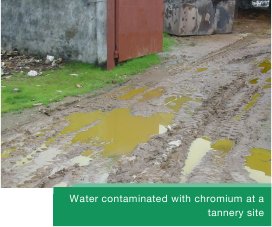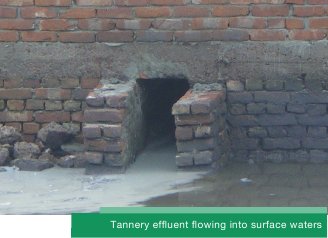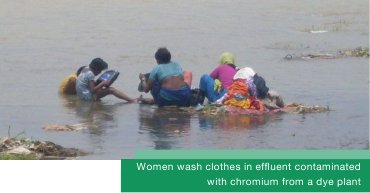Chromium
Estimated Population At Risk At Identified Sites:
7.3 Million People
Estimated Global Impact:
13 to 17 Million People
Introduction
 Chromium is a naturally occurring heavy metal that is commonly used in industrial processes and can cause severe health effects in humans. Although it can be released through natural forces, the majority of the environmental releases of chromium are from industrial sources. The industries with the largest contribution to chromium levels include leather tanning operations, metal processing, stainless steel welding, chromate production, and chrome pigment production. Chromium can be found in many consumer products, including wood treated with copper dichromate, leather tanned with chromic sulfate, and stainless steel cookware. [43]
Chromium is a naturally occurring heavy metal that is commonly used in industrial processes and can cause severe health effects in humans. Although it can be released through natural forces, the majority of the environmental releases of chromium are from industrial sources. The industries with the largest contribution to chromium levels include leather tanning operations, metal processing, stainless steel welding, chromate production, and chrome pigment production. Chromium can be found in many consumer products, including wood treated with copper dichromate, leather tanned with chromic sulfate, and stainless steel cookware. [43]
Of the chromium sites identified so far by Blacksmith Institute, roughly 75% are located in South Asia. Of these, nearly a third are associated with tannery operations, with mining and metallurgy sites also contributing significantly. The high concentration of chromium sites in South Asia is primarily due to the abundance of tanneries in the region. Many of the tanneries have poor environmental controls.
Common Exposure Pathways and Health Risks
Chromium can exist in air, water, soil, and food, and common exposure pathways include ingestion, inhalation, or dermal contact. Chromium is commonly found in two forms: trivalent chromium (chromium III) and hexavalent chromium (chromium VI). Chromium III is the most stable form of the element, and occurs naturally in animals, plants, rocks, and soils. Chromium VI rarely occurs in nature, and is usually the product of anthropogenic activities.
The health effects of chromium depend on the route of exposure and the form of the chromium. For example, inhaling chromium can cause damage to the respiratory system, whereas dermal or oral exposures generally do not. Gastrointestinal effects are generally associated with oral exposure, but not with dermal exposure. In addition, chromium VI typically causes greater health risks than chromium III. The reasons for the increased danger of chromium VI versus chromium III are complex, and relate in part to the varied paths of cellular uptake between the two forms. [44]
The primary health impacts from chromium are damage to the gastrointestinal, respiratory, and immunological systems, as well as reproductive and developmental problems. Chromium VI is a known human carcinogen, and depending on the exposure route, can increase the rate of various types of cancers. Occupational exposure to chromium VI, which often occurs through inhalation, has been linked to increased rates of cancer in the respiratory system. According to the WHO, over 8,000 workers in the tanneries of Hazaribagh, India suffer from gastrointestinal, dermatological, and other diseases, and 90% of this population die before the age of 50. [45] Separate studies in Kanpur, India also show that there is a significantly higher prevalence of morbidity in these workers, mostly from respiratory diseases owing to chromium exposure. [46]
Chromium III is considered to be less dangerous than chromium VI, although some investigations have demonstrated that chronic exposure to this form, especially in occupational settings, can significantly damage lymphocyte DNA. [47] Studies have also indicated that the broader category of chromium accumulation in the human body can have an adverse effect on the ability to metabolize iron, important because iron is essential to red blood cells. [48] As most of the human body’s iron is contained in these cells, iron deficiency anemia can occur when the body cannot absorb enough of the metal.
Industrial Sources of Chromium – Tanneries
Industry Overview
 The global leather industry is composed of three sectors of activity: animal husbandry and slaughter, tanning, and product manufacturing. Tanning is the stage in which raw leather is processed and made more durable so that it can be made into various products in the subsequent segment of the industry. Tanning is composed of three stages as well: the pretreatment of animal hides, the application of a tanning agent, and finishing the material with treatments such as drying and shining. However, these stages are not static categories, and the overall tanning process can include the sizing of hides, weaving, bleaching, carbonizing, and dyeing, as well as finishing. [49]
The global leather industry is composed of three sectors of activity: animal husbandry and slaughter, tanning, and product manufacturing. Tanning is the stage in which raw leather is processed and made more durable so that it can be made into various products in the subsequent segment of the industry. Tanning is composed of three stages as well: the pretreatment of animal hides, the application of a tanning agent, and finishing the material with treatments such as drying and shining. However, these stages are not static categories, and the overall tanning process can include the sizing of hides, weaving, bleaching, carbonizing, and dyeing, as well as finishing. [49]
The tanning of hides is a diverse practice, and includes the processing of both light and heavy leather materials. Light leather materials will eventually be manufactured into the tops of shoes and into a number of various leather products, while heavy leather materials will become belts, straps, leather used for machinery, as well as the soles of shoes. The types and concentrations of the chemicals used in the pretreatment, tanning, and finishing stages of production are also varied. Chromium is one of the most widely used chemicals throughout this process. However, other raw materials used in this process can include limestone soda ash, sulfuric acid, and sodium chlorate. The wastewater effluent from tanneries can be a dangerous source of pollutants, and often contains dissolved and suspended organic and inorganic solids, potentially toxic metal salts, chrome, and electrolytes such as sodium chloride and sulfide. [50] However, as mentioned above, the chemical composition of these effluents is subject to variation due to the diversity in the processes employed and the range of chemicals used within each stage of processing. In general, these effluents can cause environmental problems related to their high chemical oxygen demand and elevated chromium concentrations. [51]
Global Context
Because of the relatively inexpensive cost of labor and materials, over half the world’s tanning activity occurs in low- and middle-income countries. Between 1970 and 1995, the percentage of low- to middle-income countries contributing to the global production of light leather increased from 35% to 56%, and from 26% to 56% for the production of heavy leather materials. [52] The results of Blacksmith Institute’s efforts to assess polluted sites have shown that tanning facilities are highly concentrated in Nepal, Bangladesh, and India, but also frequently cause adverse health impacts in Southeast Asia, South America, and Africa.
At these sites, tanneries not only discharge contaminated wastewater into rivers, but also dump a large amount of chromium-mixed solid wastes—such as skins, hides, and fats—onto the banks of rivers and on fields near residential areas and villages. This leads to the contamination of water sources with cadmium, iron, magnesium, chromium, calcium, nickel, lead, and zinc from the addition of tanning agents, while the skin and hide treatment processes release sodium, potassium, magnesium, and copper. [53]
Effluents from tanning operations can also contaminate soils with magnesium, manganese, copper, cadmium, nickel, and lead. In addition, the pipelines and canals that transport wastewaters away from these industrial facilities often run through villages, where they occasionally leak into surrounding soils or are used to irrigate crops.
Exposure Pathways from Tanneries
 People can be exposed to the contaminants produced by tanning through various pathways. The most common occupational hazard is inhalation of chromium at the work site. However, the populations near a tannery are often exposed to pollutants through contaminated water. People use the water from contaminated rivers and streams for several purposes, including irrigation, swimming (mostly children), bathing, and washing dishes and clothing. There is also a high risk of this hazardous waste water mixing with the ground water, which is extracted for drinking water. In the largest tannery region of Bangladesh, Hazaribagh, more than 200 tanneries generate 7.7 million liters of liquid waste and 88 million tons of solid waste every day. The direct discharge of these wastes has contaminated the ground and surface water with dangerously high concentrations of chromium, as well as cadmium, arsenic, and lead. [54] The contamination of rivers also allows these pollutants to accumulate in common fish and shellfish species, which are used as local food sources.
People can be exposed to the contaminants produced by tanning through various pathways. The most common occupational hazard is inhalation of chromium at the work site. However, the populations near a tannery are often exposed to pollutants through contaminated water. People use the water from contaminated rivers and streams for several purposes, including irrigation, swimming (mostly children), bathing, and washing dishes and clothing. There is also a high risk of this hazardous waste water mixing with the ground water, which is extracted for drinking water. In the largest tannery region of Bangladesh, Hazaribagh, more than 200 tanneries generate 7.7 million liters of liquid waste and 88 million tons of solid waste every day. The direct discharge of these wastes has contaminated the ground and surface water with dangerously high concentrations of chromium, as well as cadmium, arsenic, and lead. [54] The contamination of rivers also allows these pollutants to accumulate in common fish and shellfish species, which are used as local food sources.
These effluents eventually contaminate nearby soils with heavy metals. Studies, such as one in Syria, indicate that the chromium-contaminated soil poses a significant health hazard, as the direct inhalation and ingestion of soil allows chromium to accumulate in both humans and livestock. [55] In addition, the chromium-laced solid wastes from tanneries are often converted into poultry feed—as is the case in areas of Bangladesh—and can thus impact livestock and humans. [56]
Soil contamination can also negatively impact agriculture. Commonly, the wastes generated during tanning are added to commercially available organic fertilizers, and chromium can accumulate in standard food crops. [57]
What is Being Done
Blacksmith Institute has experience mitigating risks from chromium waste. Ground water contaminated with chromium VI can be treated by introducing an electron donor into well water to convert chromium VI to the less toxic chromium III. When soils and solid waste pose health risks, excavation and removal are cost-effective measures to break the pathway between the contaminant and the local population. Additionally, recent research has targeted the use of particular salt-tolerant bacteria, such as those from the Arthrobacter genus, as potential agents to reduce chromium levels in tannery waste-contaminated soil. [58] Similar studies demonstrate the ability of bone charcoal—a granular material produced by charring animal bones—to remove chromium from water. [59] Vermiculture, in which worms are used to concentrate heavy metals, is another potentially cost-effective form of bioremediation. The construction of waste treatment facilities and secure landfills can also significantly reduce health risks, and these methods are often used in tandem to remediate polluted sites.
Footnotes
[43] U.S. Department of Health and Human Services. “Toxicological Profile for Chromium.” Georgia: Agency for Toxic Substances and Disease Registry, 2008.
[44] Ibid.
[45] J. Maurice. “Tannery Pollution Threatens Health of Half-Million Bangladesh Residents.” Bulletin of the World Health Organization 79.1, 2001.
[46] Subodh Kumar Rastogi, Amit Pandey, and Sachin Tripathi. “Occupational Health Risks among the Workers Employed in Leather Tanneries at Kanpur.” Indian Journal of Occupational Medicine 12.3 (2008): 132–135.
[47] M.G. Medeiros, et al. “Elevated Levels of DNA-Protein Crosslinks and Micronuclei in Peripheral Lymphocytes of Tannery Workers Exposed to Trivalent Chromium.” Mutagenesis 18.1 (2003): 19–24.
[48] C. Kornhauser, et al. “Possible Adverse Effect of Chromium in Occupational Exposure of Tannery Workers.” Industrial Health 40.2 (2002): 207–213.
[49] V.M. Correia; T. Stephenson, and S.J. Judd. “Characterisation of Textile Wastewaters – A Review.” Environmental Technology 15.10 (1994): 917–929.
[50] R. Jenkins, J. Barton, and J. Hesselberg. “The Global Tanning Industry: a Commodity Chain Approach.” Environmental Regulation in the New Global Economy: the impact on industry and competitiveness: Edward Elgar Publishing (2004): 157–172.
[51] Z. Song, C.J. Williams, and R.G.J. Edyvean. “Sedimentation of Tannery Wastewater.” Water Research 34.7 (2000): 2171–2176.
[52] R. Jenkins, J. Barton, and J. Hesselberg. “7. The Global Tanning Industry: a Commodity Chain Approach.” Environmental Regulation in the New Global Economy: the impact on industry and competitiveness: Edward Elgar Publishing (2004): 157–172.
[53] Saadia R. Tariq, Munir H. Shah, N. Shaheen, A. Khalique, S. Manzoor, and M. Jaffar. “Multivariate Analysis of Selected Metals in Tannery Effluents and Related Soil.” Journal of Hazardous Materials 122.1-2 (2005): 17–22.
[54] Bhuiyan, et al. “Investigation of the Possible Sources of Heavy Metal Contamination in Lagoon and Canal Water in the Tannery Industrial Area in Dhaka, Bangladesh.” Environmental Monitoring and Assessment, 2010.
[55] A. Möller, H. W. Müller, A. Abdullah, G. Abdelgawad, and J. Utermann. “Urban Soil Pollution in Damascus, Syria: Concentrations and Patterns of Heavy Metals in the Soils of the Damascus Ghouta.” Geoderma 124.1-2 (2005): 63–71.
[56] A.M. Hossain, et al. “Heavy Metal Concentration in Tannery Solid Wastes Used as Poultry Feed and The Ecotoxicological Consequences.” Bangladesh Journal of Scientific and Industrial Research 42.4 (2007): 397–416.
[57] V.P. Grubinger, W.H. Gutenmann, G.J.Doss, M.Rutzke, and D.J. Lisk. “Chromium in Swiss Chard Grown on Soil Amended with Tannery Meal Fertilizer.” Chemosphere 28.4 (1994): 717–720.
[58] M. Megharaj, S. Avudainayagam, and R. Naidu. “Toxicity of Hexavalent Chromium and Its Reduction by Bacteria Isolated from Soil Contaminated with Tannery Waste.” Current Microbiology 47.1 (2002): 51–54.
[59] S. Dahbi, et al. “Removal of Trivalent Chromium from Tannery Waste Waters Using Bone Charcoal.” Analytical and Bioanalytical Chemistry 374.3 (2002): 540–546.




